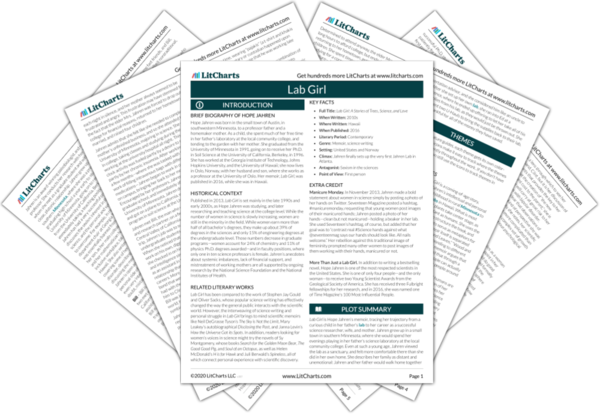Jahren is honest and forthcoming about her mental illness, describing the effects of bipolar disorder with honesty and humor. This candid self-portrait of a highly educated and successful woman living with mental illness goes a long way towards ending the stigma surrounding mental health. This is particularly important in her field, where scientists are expected to be unemotional and clinical, separating their personal selves from their methodical, objective experiments While Jahren does not portray herself as an activist, she conducts important work by normalizing bipolar disorder, and ultimately stressing the trifold need for awareness, action, and (in her case) medication.
Just as she demystifies science, Jahren also works to demystify bipolar disorder by outlining her early symptoms in the hopes of raising awareness and opening up the conversation about mental illness. There were some early signs of bipolar disorder in her young life: As a college student, Jahren notes that she had endless energy, “which seized me in ferocious spurts, keeping me awake for days at a time.” At that point, however, those early signs were easy to brush it off as youthful buoyancy, intellectual energy, and intermittent sleeplessness, and would only later become a cause for concern. She recognizes that something may be wrong when, months after she begins her faculty position in Atlanta, she finds herself at baggage claim in the airport and cannot recall how she got there. She admits that this has been happening frequently, but her concerns are brushed aside by her doctor, who simply blamed it on the stress of her job. This only exacerbates the problem by putting more pressure on Jahren to resolve her mental health issues without medical help. And although she is able to infuse many of her mental health struggles with humor, Jahren is aware of the potentially detrimental effects of her manic episodes. For example, her insistence that she, Bill, and their lab assistants drive cross-country, through a major snowstorm, to a conference resulted in a near-death experience on a highway en route to California. This was one of many signs that Jahren should not allow her bipolar disorder to go unchecked.
Besides highlighting the need for awareness surrounding mental illness, Jahren also stresses the importance of taking action—for her, this meant finding the right doctor and the proper medication. Jahren first takes action by finding the right doctor, who tells her that she does not have to continue suffering as she has in the past. Noting with humor that she is not “afraid of anything made in a laboratory,” Jahren gratefully accepts the medication that will keep her moods in balance for much of her adult life. She emphasizes that the medication is truly needed, as it will help her refrain from chewing on her hands and banging her head against the wall. She then returns to the question of the management of her illness when she is pregnant and consequently unable to take her medication. She explains that from the moment she knows she is pregnant until week 26, when the fetus is sufficiently developed, she “cannot take Depakote or Tegretol or Seroquel or lithium or Risperdal,” all medications that are necessary to manage her mental illness. She compares the immediate cessation of medication to standing on the railroad tracks, waiting for the train to hit, as she fully expects to experience at least one major manic-depressive episode during the first six months of her pregnancy. While a doctor announces to a group of medical student that this patient “has a severe risk for postpartum psychosis,” Jahren beats the odds and manages to maintain her mental health in the period after having her son. It is only with the help of others—doctors, friends, and her very supportive husband—that Jahren is able to strike a balance in her life.
While discussing the history of Arctic ecosystems, Jahren explains that they are “better characterized as ‘resilient’ than ‘stable’”; Jahren herself embodies this distinction between stability—something she probably would have had, but never wanted, back in her small town in Minnesota—and resilience. Her mental illness is a part of her life, for better and for worse, but it is not something that she has to hide out of shame or fear. While Jahren has never suggested that this was her objective, her honest portrayal of living with, managing, and even thriving with bipolar disorder helps to normalize it within society, taking mental illness out of the psych ward and into the highest levels of academia.
Mental Illness and Treatment ThemeTracker

Mental Illness and Treatment Quotes in Lab Girl
While this great cosmic fire hose bathes you in epiphanies, you are overtaken by your urgent need to document them and thus are an inspired manual for all perfect tomorrows. Unfortunately, this is when reality closes ranks and conspires to thwart you in earnest. Your hands shake such that you can’t hold a pen. You pull out a tape recorder and push “record” and fill cassette after cassette.
A manic-depressive pregnant woman cannot take Depakote or Tegretol or Seroquel or lithium or Rsiperdal or any of the other things that she’s been taking on a daily basis for years in order to keep herself from hearing voices and banging her head against the wall. Once her pregnancy is confirmed she must cease all medications quickly (another known trigger) and stand on the train tracks just waiting for the locomotive to hit.
I know that I am supposed to be happy and excited. I am supposed to be shopping and painting and talking lovingly to the baby inside me. I am supposed to celebrate the ripening fruit of love and luxuriate in the fullness of my womb. But I won’t do any of this.











